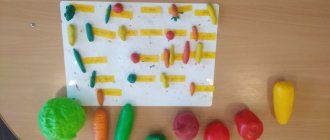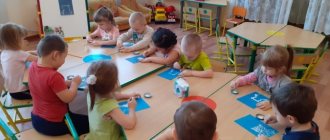Treat for the guest: summary of a modeling lesson in the middle group
Serovskaya O.A., Rybakova G.V., Evdokimova L.Yu. Treats for guests: summary of a modeling lesson in the middle group // Sovushka. 2019. N1 (15). URL: https://kssovushka.ru/zhurnal/15/ (access date: 11/21/2021).
Order No. 251575
Program content: continue to cultivate children's interest in modeling. Strengthen the ability to sculpt the shape of a disk, rhythmically decorate a rounded flat shape with rollers, apply a pattern in the form of stripes and dots in stacks. Teach children how to make challah by intertwining two or three sausages.
Material: plasticine or puff pastry, stacks, toys, doll plates, boards.
Progress of the lesson:
The doll table is covered with a tablecloth and served with doll dishes. There are various toys sitting at the table.
The teacher says: “Today, when I came to kindergarten, I accidentally heard our dolls talking. It turns out that their friends, the bunnies, are coming to visit them. All the residents of the play corner decided to prepare for the meeting of the guests and agreed on who could do what. The dogs swept the floor. The squirrels set the tables with tablecloths and napkins. The cats set out the dishes for tea. The dolls put on their most beautiful dresses, did their beautiful hairstyles - they are ready to meet the guests - the hares. But what should we treat them with? But then the bear remembered that bunnies love cookies, bagels and such beautiful braided buns that look like girls’ braids, but none of us know how to bake them.
Then everyone was upset, and the bear said: “Maybe the guys will make us such a treat, then the bunnies will be happy, and we’ll try them too.”
The teacher asks if the children want to start preparing a treat?
Having received their consent, he invites the children to first make a lot of different cookies and bagels. The teacher also invites the children to learn how to “bake” challah (similar to girls’ braids). Demonstration: divide a piece of dough or plasticine into three identical lumps, then roll them into three identical sausages. Having placed the sausages in a row on the board, we connect their upper ends, and then weave a braid. If weaving from three sausages is difficult for some children, instead of three sausages, they can make it from two.
During the work, the teacher helps by suggesting the sequence of actions.
When everyone has finished modeling, the teacher offers to help the dolls set the tables. Here the bunnies arrive on the train. The dolls meet them and invite everyone to sit down at the table, treating everyone to cookies, bagels, and challah. The teacher plays out the scene. The animals thank the children for the treats.
GCD move
V.: Children, good morning! I suggest you go to a magical forest. To do this you need to say the magic words:
We found ourselves in a fairy-tale clearing. Who is this sitting in front of you? (Bear)
Hello Mishka!
Tell us what you want to ask the guys .
Bear: I want a friend, kind and cheerful. Listen to the riddle:
What kind of forest animal is this?
Stood up like a post under a pine tree,
And stands among the grass,
V.: Who is Mishka talking about? (about the hare)
.
We know bunnies from different fairy tales. What kind of fairy tales are these, name them. (Gingerbread Man, Fox and Hare, Teremok)
.
— Guys, what body parts does a hare have?
Children: Head, tummy , ears, paws, tail.
Q: Tell me, what shape is the hare’s body? (column)
Head?
(round)
Now we take the plasticine in our hands, knead it well, divide it into two parts - larger and smaller. How should you sculpt the body? You need to roll out a larger piece of plasticine with straight movements of your palms to make a sausage. Then, in a circular motion, roll out the second piece of plasticine , give it a round shape - this will be the head, attach it to the body.
Please note that first the head is attached to the body, then the legs, ears, and tail. We will either pinch them or sculpt them separately and attach them to the body and head. (show)
You should try to lubricate each part tightly when connecting. Here, Mishka, I made you one friend.
M.: I want me to have more friends - chickens, ducklings, dogs, bears just like me. Maybe the children will recommend someone else to me as friends?
Notes on artistic and aesthetic development “Make whatever toy animal you want”
Maria Mezhekova
Notes on artistic and aesthetic development “Make whatever toy animal you want”
Region Artistic and aesthetic development OOD Lepka
Topic: “
Make whatever toy animal you want ” (within the framework of the theme week)
Dramatization of the fairy tale
“Mitten”
Purpose: Creating a social situation of development in the process of dramatizing the fairy tale
Objectives: 1. Reinforce sculpting techniques and the ability to carefully use material
2. Promote the development of fine motor skills_
3. Foster independence and activity
5. Development of orientation in space.
6. Development of visual attention
7. Development of micro-coordination of fingers
Type of children's activity: communication with adults, productive
Abstract of the OOD topic “Make whatever animal you want.”
Abstract of the OOD topic “Make whatever animal you want.”
Purpose: To strengthen children’s ability to sculpt an animal (optional).
Tasks:
- learn to sculpt round and elongated objects, more accurately conveying the characteristic features of the object;
— improve techniques for rolling out plasticine with straight and circular movements of the palms;
- consolidate sculpting techniques and connecting parts;
— develop the ability to carefully handle materials and equipment;
- cultivate imagination and creativity.
Materials and equipment: toy animals (bear, hare, duck, chicken, etc., color illustrations, plasticine, modeling boards, recordings of Mozart’s sonnets.
Preliminary work: reading fairy tales and riddles about animals, watching birds on a walk, feeding the birds.
Methodical techniques:
- looking at toy animals;
- repetition of rolling movements in the air;
- looking at ready-made animals and writing a fairy tale about them.
Planned results: children participate in a joint conversation, answer the teacher’s questions, take part in productive activities, in a play situation with Mishka.
OOD progress.
1. Org. moment.
Educator: Children, good morning! I suggest you go to the magical forest. To do this you need to say the magic words:
One, two, three, four - everyone closed their eyes together.
We turned around, circled around, and found ourselves in a clearing!
Open your eyes.
We found ourselves in a fairy-tale clearing. Who is this sitting in front of you? (Mishka) Hello Mishka! Tell me what you want to ask the guys.
Bear: I want a friend, kind and cheerful. Listen to the riddle here:
What kind of forest animal is this?
Stood up like a post under a pine tree,
And stands among the grass,
Are your ears bigger than your head?
Educator: Who is Mishka talking about? (about the hare). We know bunnies from different fairy tales. What kind of fairy tales are these, name them. (Kolobok, Fox and Hare, Teremok).
(Show illustrations).
Educator: I agree with you, Mishka, that Bunny will be a good friend to you - he is kind, he let Fox in when she had nowhere to live, did not eat Kolobok, and came to live in Teremok. How can you make such a friend for Mishka? Shall we try to make a Bunny? Guys, what body parts does a hare have?
Children: Head, tummy, ears, paws, tail.
Educator: Tell me, what shape is the hare’s body? (column) Head? (round)
Now we take the plasticine in our hands, knead it thoroughly, divide it into two parts - larger and smaller. How should you sculpt the body? You need to roll out a larger piece of plasticine with straight movements of your palms to make a sausage. Then, in a circular motion, roll out the second piece of plasticine, give it a round shape - this will be the head, attach it to the body.
Progress of educational activities
Stage OD Organization of space Activities of adults Activities of children Psychological and pedagogical conditions/conditions of the social situation of development
animals on the board . B conducts a conversation with children about wild animals .
Invites you to carefully examine the pictures that depict wild animals . He asks the guys what shape the main parts of the animal’s .
Conditions for developing interaction skills and encouraging speech activity.
Conditions for the development of research activities
Plasticine, boards, stacks (for each child, pictures of wild animals Visual gymnastics.
Invites children to make whatever animal they want . He offers to show with his hands in the air how they will sculpt the animal . During the lesson, direct the children’s attention to a more accurate representation of the shape and size of the parts
Performance of work Conditions for the development of independence .
Conditions for the development of fine motor skills .
Together with the children they look at crafts. Praises for a job well done. Review their work. Conditions for the development of research activities
Conditions for the development of independence and initiative
"Kitty."
Abstract of the GCD on artistic and aesthetic development Topic: “Kitty” Educational areas within which the lesson is conducted: Artistic and aesthetic development, social and communicative.
Author's didactic game for developing the speech of children in kindergarten “Guess what animal this is?” Author's didactic game for the development of speech of children in kindergarten: “Guess what animal this is?” Goal: to teach children to write descriptive essays.
Abstract of the GCD on artistic and aesthetic development “Berry Story” Age group: 2nd junior group Integration of areas - artistic creativity, cognition (ecology, music, communication. Goal: continue.
Source




